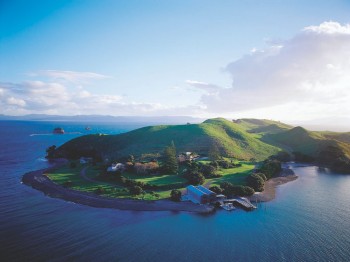The Mercury Islands are a group of seven islands eight kilometres off the north-east coast of the North Island of New Zealand. The six smaller islands in the group are now rodent free after eradication exercises between 1987 and 1997 removed Pacific Rats Rattus exulans. They have been identified as an Important Bird Area by BirdLife International because they support up to 3000 breeding pairs of Vulnerable Pycroft's Petrels Pterodroma pycrofti, as well as Little Shearwaters Puffinus assimilis.
The largest island (at 1872 ha) is privately-owned Ahuahu-Great Mercury of which one-third is managed for sheep and beef farming, one third as forestry and the remaining third as native forests, wetlands and dunes. Great Mercury supports a population of Grey-faced Petrels Pterodroma macroptera gouldi - rediscovered in 2012 - as well as of rats Rattus sp..

Great Mercury Island
Following the temporary removal of the domestic stock poison bait is to be spread by helicopter this austral winter as a public-private partnership between the island’s owners and the New Zealand Department of Conservation to remove the rats (click here). A campaign will also be initiated to remove the island’s feral Domestic Cats Felis catus. Restoration plantings, weed management and fencing have been ongoing on the island since 1979. Possible introductions of threatened native species may be considered over time.
See also news items in the Waikato Times and National Geographic News Watch.
Selected Literature:
Grace, A.B. 1976. The Birds of Great Mercury Island, north-eastern New Zealand. Tane 22: 65-69.
John Cooper, ACAP Information Officer, 10 July 2014

 English
English  Français
Français  Español
Español